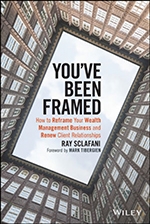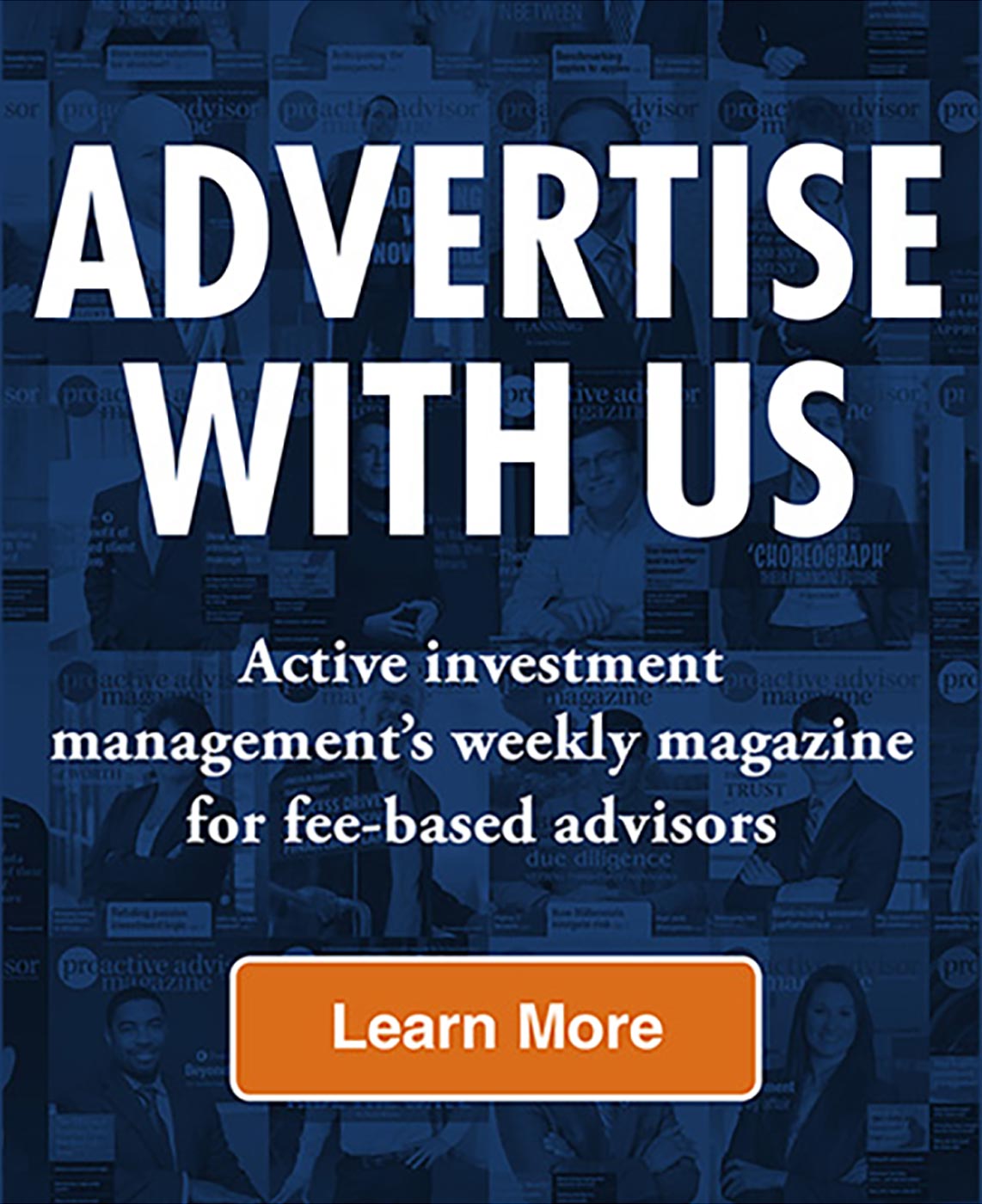How do clients view your firm? The questions you should be asking
How do clients view your firm? The questions you should be asking

Financial advisors need to be more relevant than ever in the lives of their clients, know who they serve and why, and design a total solution to meet client needs. Understanding the current “framing” of your practice by clients is an important first step in this process—and can be facilitated via a very specific client conversation.
In the article “10 practice secrets from ‘the best in the business’,” we asked the question, “Have you wondered how top financial advisors and wealth managers are able to continuously grow their client base, assets under management, and revenues while solidifying long-term relationships with clients?”
In that article, we shared 10 core principles that Ray Sclafani has identified as drivers of business growth and client satisfaction for top financial advisors.
Mr. Sclafani is the founder of ClientWise, a premier coaching company exclusively serving the financial-services industry. A professional certified coach and the holder of a master’s certification in neurolinguistics, Mr. Sclafani leads a firm that has trained thousands of financial advisors in advanced practice management principles and methodologies to achieve more consistent success. He says these principles are based on years of studying and analyzing the best practices of financial firms of all sizes—both here and abroad.
In his 2016 book, “You’ve Been Framed,” Sclafani tackles the opportunities financial advisors have “to create change by the way in which they conduct their practices.” He says that “financial advising is a noble profession” that is capable of not only impacting the current generation of clients that financial advisors work with but also “carries forward through multiple generations.”
The core thesis of the book explores how financial advisors “are framed.” According to the introduction to the book, “The frame is the perspective outsiders have of your company. It may be accurate or false. Positive or negative. But if you haven’t actively nailed down what your business stands for—and what differentiates it from competitors—you’re likely reducing profits, talent, and the longevity of your firm.”
“You’ve Been Framed” outlines a process by which financial advisors can take control of their firm’s “frame” to attract prospects into their pipeline, win the next generation of clients, and deepen their businesses so they can “thrive long into the future.”
Why have “the client conversation”?
Integral to that process, says Sclafani, is the important first step of gaining a deep understanding of how your current clients view your firm—and the questions you should be asking to ascertain that answer.
He writes,
“Whether advisors choose to deliver all of the products and services related to their particular brand of wealth management or not, being relevant in the life of the ideal client, knowing who they serve, and designing a total solution to meet the needs of that client are paramount. …
“It is also time in the twenty-first century for advisors to review what kind of value they provide and how they do it. In today’s consumer-friendly marketplace, where the client has ample access to information, opportunities galore to do it him- or herself, and plenty of choices of whom to use as a provider of financial services, the advisor no longer has the liberty of simply deciding what he or she wants to provide to the client. The wise advisor invites clients into the process of defining what is of value to them.”
Sclafani adds,
“Not that it is all drudgery and obligation—along the way, the advisor has the freedom to refine the value the client needs so it matches the advisor’s passion and strengths. In some cases, the advisor may seek out a new, better-matched target-client base if the gap between what the client wants and the advisor can deliver is large, or the advisor may build out a team to address gaps. In any case, the conversation must always begin with the client; from there, the advisor can shape this newly gained understanding to create a firm that can serve the right people in the right way.”
Setting the stage for the client conversation
Sclafani recommends using a very clear script and set of talking points for how the conversation should run. His firm has branded this proprietary process as The ClientWise Conversation and has field-tested the entire process for over 10 years with more than 50,000 financial advisors.
The ultimate goal of the conversation, he says, “is to collect data from the marketplace today so you can look for patterns and get a clear picture of how you are being framed … or mis-framed, as the case might actually be.”
He notes,
“For example, do your clients see you as selling insurance without realizing that you also provide guidance on building an investment portfolio? Do your clients perceive you as old school, even though you now have advisors on staff who are from the millennial generation? Do your clients think you operate solo when, in fact, you have a team?
“Chances are that as you discover how clients frame you, you will also discover that to some degree they mis-frame you, meaning that there is a gap between the value they understand you to provide and the kind of value you actually provide.”
Sclafani strongly recommends that advisors themselves conduct the conversation, interviewing 20 to 30 clients for a period of about 20 to 30 minutes. There can be exceptions as to who could conduct the interview, whether it is a coach, HR representative, or chief marketing officer, but Sclafani believes the firm’s principal will greatly benefit from hearing the information firsthand. He also recommends that this conversation ideally be held as a separate meeting, not as an add-on to a client review session.
Sclafani offers some specific tips for how to initially position the meeting to clients.
He suggests that advisors should explain,
“That you are looking for ways to improve your practice … because your business is growing, and … that you are calling a select few clients … whose opinions you respect a great deal, like theirs … and would it be possible for them to meet with you in person within a reasonable time frame, such as the next week or two, for 20 to 25 minutes … so you can get some feedback on what’s working, what’s not working, and what could be done to improve their experience with your firm.”
Sclafani says, “With a lead-in like that, how can your client say anything but yes?”

What specific questions will best elicit critical information from clients?
Sclafani says when then the client meeting starts, ask the following five questions in order. There is an intentional sequence to the order, and the conversation will build in the most productive fashion. He emphasizes, “It’s important to word them as they are shown here. The wording has been chosen expressly and has been tested across thousands of situations.”
He points out that the wording has been chosen according to neurolinguistic research principles. For example, “People tend to freeze up or struggle to answer a question about ‘the most important’ something, whereas they answer ‘what is the one thing’ types of questions with greater ease and creativity.”
The ClientWise Conversation questions are presented here, with brief explanations and rationale from Sclafani provided for each one.
- “What is the one thing you value most about how my firm and I serve you?”
This question allows you to begin the process by gathering positive information, which is likely to put you and the client at ease. It is a means of determining how exactly the client perceives your value as a professional. As with all of the questions, be prepared to ask logical follow-up questions in the natural flow of the conversation.
- “What is the one thing you would most like me to change, or improve, about my firm and how I serve you?”
With this question, you are moving on to gather information about how you can be a more effective partner to your clients. If the answer resonates and/or you discover a pattern across multiple clients, you can build this change into your practice’s “reframe.”
- “If you were to describe the services that my firm and I offer to clients like yourself, what would you say?”
Sclafani says that while this question would appear most likely to result in a description of tangible products and services, it more often receives far more qualitative answers. These tend to be in the areas of the quality of the relationship and how the advisor has become a “trusted advisor” or “helps take care of my family’s financial future.” He says both advisors and clients gain “a firsthand understanding, in the moment, of how much value the trusting relationship brings to clients.”
- “How would you describe what it is that we have achieved together?”
This is a powerful question, says Sclafani, that gets clients to say in their own words what you have achieved together. When clients believe they have achieved something and are able to articulate that something, “there is magic.” The client makes a real connection between what you do as an advisor and why that is valuable to him or her.
- “Among your other professional advisors, who do you trust the most and why?”
There are two excellent findings that advisors get out of this question, says Sclafani. First, it is important to hear about other trusted advisors that the client relies on and the nature of those relationships. Second, it is a great source of information in terms of building a network of high-quality professionals with expertise that may be of value to your firm and your clients. Says Sclafani, “As you are building your network, you are also creating goodwill with the clients and deepening their potential trust in you. … You will truly be able to take care of them because you have a robust team, not just of partners, but of partners that your clients trust.”
Wrap-up
The ClientWise Conversation requires a careful close. Thank the client for their valuable input. Ask permission to have a brief follow-up conversation in the future to share key insights from the entire process and brief them on any value-added changes you might be incorporating for your practice. Make sure they know how important their participation was and how their opinions will help shape the future direction of your firm.
FIVE STEPS TO A SUCCESSFUL CLIENTWISE CONVERSATION
- Meet with the client in person rather than over the phone; it’s more personal and gives the client time and space to provide more in-depth answers.
- Make the meeting one-on-one, rather than showing up with three team members and risking intimidating the client.
- Come from a position of strength, not weakness. Explain to the client that as your business continues to grow, you are always looking for ways to improve and better serve your clients.
- Avoid becoming defensive; instead, let the client know that his or her insight is important to you, listen, and take notes to show you are taking the client seriously.
- Use the five most important words early and often: “Tell me more about that.”
From conversation to analysis
When all of the sessions are completed, think back to your clients’ responses and consult your notes. With everything refreshed in your mind, says Sclafani, begin to do the following:
- Look for patterns in client responses.
- Ask your team for input and reaction to client responses.
- Ask yourself: What words and phrases were heard often?
- Identify the gaps between how the client frames you and how you want to be framed.
- Determine how you and your team can use what you have discovered in your daily work, beginning right away.
- Start documenting what you achieve every quarter with each of your clients.
In this process, says Sclafani, you will have gathered data that allows you to create a baseline of how you are being framed by your clients. You will have “a rich pool of information that you can analyze and identify patterns in how clients view your services, what they value most about you, and the things they would like to see you change. … No longer will you have to guess at how to frame yourself for clients; you’ll have the information needed to create your desired reframe.”
The key benefit of this part of the reframing process, says Sclafani, is having a data- and discovery-driven first step, within the valuable context of a frank and personal discussion with clients. Importantly, the conversation is not about financial planning or investments, but about their opinions and needs and what they value most about your relationship.
He says, “Asking clients what they value about your firm and what they would change about your services can result in new insights and new ideas for you, and more personalized services for your clients.”
 The opinions expressed in this article are those of the author and do not necessarily represent the views of Proactive Advisor Magazine. These opinions are presented for educational purposes only.
The opinions expressed in this article are those of the author and do not necessarily represent the views of Proactive Advisor Magazine. These opinions are presented for educational purposes only.
Proactive Advisor Magazine wishes to thank Ray Sclafani and ClientWise for permission to use webinar and website material and excerpts from the book, “You’ve Been Framed.” Cover image by Corbis Images/Getty Images. Mr. Sclafani’s book, published by John Wiley & Sons, Inc. in 2016, can be obtained at www.wiley.com or at Amazon.
 David Wismer is editor of Proactive Advisor Magazine. Mr. Wismer has deep experience in the communications field and content/editorial development. He has worked across many financial-services categories, including asset management, banking, insurance, financial media, exchange-traded products, and wealth management.
David Wismer is editor of Proactive Advisor Magazine. Mr. Wismer has deep experience in the communications field and content/editorial development. He has worked across many financial-services categories, including asset management, banking, insurance, financial media, exchange-traded products, and wealth management.
Recent Posts:

